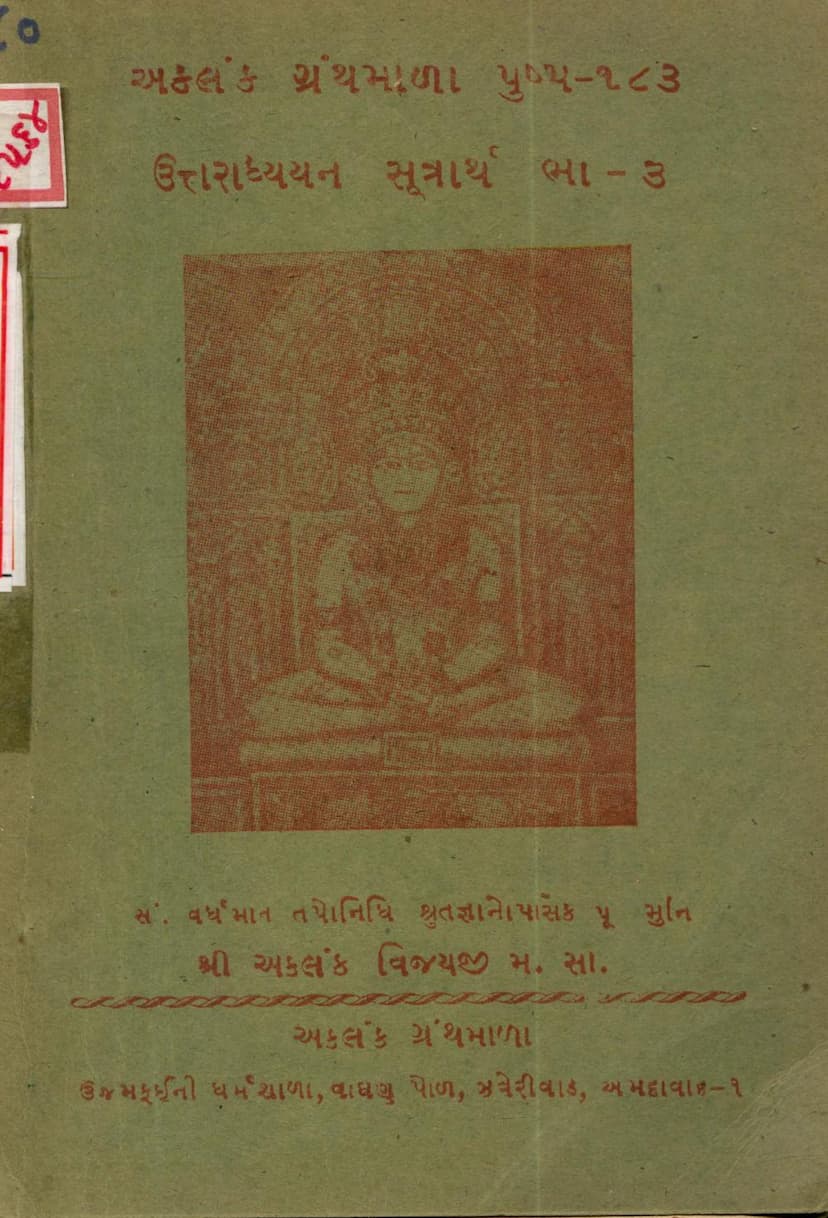Uttaradhyayan Sutra Part 03
Added to library: September 2, 2025

Summary
The provided text is the third part of the Uttaradhyayan Sutra (also known as Uttarajjhayaṇa Sutta), a foundational text in Jainism. This particular volume, published by Akalank Granthmala, contains chapters 19 through 28 of the Uttaradhyayan Sutra.
Here's a summary of the content, based on the provided pages:
Overall Purpose and Context:
- This volume is part of a larger series of four books intended to present the complete Uttaradhyayan Sutra with its commentary (Sutrartha).
- The Uttaradhyayan Sutra is a collection of dialogues, teachings, and stories that encapsulate the core philosophy and ethical guidelines of Jainism.
- The goal of this publication is to make these ancient teachings accessible to a wider audience, including both scholars and lay practitioners, through simple language and clear explanations.
Content of Part 3 (Chapters 19-28): The preface explicitly lists the chapters included in this part:
- Chapter 19: Mrigaputra: This chapter tells the story of Prince Mrigaputra, who, upon seeing a Jain monk, experiences jati-smaran-jnana (knowledge of past lives). He recounts the sufferings of past lives to his parents and expresses his desire to renounce the worldly life for asceticism. The dialogue between the son and parents regarding renunciation is highlighted as a point of reflection for the reader. The chapter emphasizes the suffering in hellish realms and the importance of vairagya (detachment) for liberation.
- Chapter 20: Anath Muni: This chapter features the story of Anath Muni and King Shrenik. Their discussions revolve around the theme of vairagya (detachment). The text recommends reading the complete story in a separate publication in the style of Shrimad Rajchandra. It also touches upon the importance of knowledge-driven action over mere ritualistic practices.
- Chapter 21: Samudrapala: This chapter details the story of Samudrapala, a merchant's son who, after witnessing a public execution, develops profound detachment and renounces the world.
- Chapter 22: Rathnemi: This chapter narrates the story of Rathnemi, brother of Lord Neminath. Despite being initiated, he is affected by desires. The chapter describes his interaction with Rajimati, his repentance, and the teachings imparted to him.
- Chapter 23: Kesh-Gautam: This chapter presents a religious discussion between Kesh Muni (from the time of Lord Parshvanath) and Gautam Swami (disciple of Lord Mahavir). Gautam Swami clarifies Kesh Muni's doubts.
- Chapter 24: Pravachan Mata: This chapter focuses on the "Eight Great Mothers" or Ashta Pravachan Mata, which refers to the five samitis (conducts) and three guptis (restraints) – essential principles for Jain monks and nuns.
- Chapter 25: Yajna (Sacrifice): This chapter likely discusses the concept of sacrifice in Jainism, possibly contrasting it with Vedic rituals.
- Chapter 26: Samachari: This chapter details the Samachari or the code of conduct for Jain ascetics, emphasizing the ten essential practices (Dashlakshana) and the importance of the eight limbs of Pravachan Mata.
- Chapter 27: Alanka (Ornaments): This chapter might discuss the inner "ornaments" of an ascetic, such as virtues, rather than external adornments.
- Chapter 28: Moksha-Marg-Gati: This chapter likely outlines the path to liberation (Moksha).
Key Themes and Messages:
- The nature of suffering: The text repeatedly emphasizes the intense suffering in hellish realms and the transient, painful nature of worldly existence.
- Detachment (Vairagya): A central theme is the importance of cultivating detachment from worldly pleasures, possessions, and relationships to achieve spiritual liberation.
- The path to liberation: The Uttaradhyayan Sutra, as presented in this volume, guides the reader towards the path of righteousness, knowledge, right conduct, and penance as the means to attain Moksha.
- The importance of knowledge and right conduct: The text stresses that true liberation comes from understanding the Jain principles and living accordingly, rather than blind ritualism.
- The significance of past lives and karma: The stories often refer to past lives and the consequences of karma, highlighting the cyclical nature of birth, death, and rebirth.
Publisher's Mission: The publisher, Akalank Granthmala, seems dedicated to propagating Jain philosophy through affordable and accessible literature. They express a desire to make these valuable texts available to everyone, even at a nominal cost.
In essence, this third part of the Uttaradhyayan Sutra continues the profound spiritual journey, offering detailed narratives and philosophical discussions aimed at guiding individuals towards a life of righteousness and ultimate liberation.